
21 minute read
The passing of a legend
Industry Pioneer
Frank Yukich - the passing of a prophet
Advertisement
TESSA NICHOLSON
DETERMINED, VISIONARY, indefatigable and a prophet. These are descriptions offered by those who knew Frank Frank places a silver coin in a hole in which a vine is to be planted, Yukich, who died on October 21, aged 89. in 1973. Phot from Marlborough Museum Frank was the stuff legends are made of, and his single- Marlborough was clandestine. Under the auspices of a minded dedication to placing New Zealand wine on the company known as Cloudy Bay Properties, (yeah, that’s world map changed this country’s wine industry forever. part of the legend), Frank and Wayne drove around the His legendary status as the head of Montana Wines is province settling on nine potential properties. Times were irrefutable. The company begun by his father Ivan back in tough in Marlborough at the time and Frank capitalised the 1940s was for many years the producer of some pretty on that. Despite none of the properties actually being on ordinary wines on a small scale. It was in the late ‘60s and the market, he convinced nine owners to sell straight out, early ‘70s, when Frank was heading the company, that the without telling anyone what he wanted the land for. Those vision changed somewhat. He wanted to move away from nine properties equated to 2,900 acres (1,175 hectares), and producing sheer volumes of wine, to producing wines of cost $1.4 million. quality that would take New Zealand to the world. It was all very well having a great idea, but a non-refundable Looking to expand the company’s holdings outside of deposit of 10% was required to secure the deals. Given the Auckland, Mangatangi and Gisborne, he considered Montana board had no idea what Frank was up to, he had to Hawke’s Bay, but looked to Marlborough instead, after raise the funds himself, which he did by mortgaging his own speaking to young DSIR scientist Wayne Thomas – soon to Auckland property.become Montana Wines’ head viticulturist- about growing Once the deposits had been made, Frank told the board wines that could be exported. Frank always gave credit to about the Marlborough expansion, looking for a refund Wayne for convincing him to have a look at the top of the of the deposit. But the board refused to endorse the land South Island. purchases, leaving Frank facing a $140,000 debt.In July 1973, Frank and Wayne flew into Marlborough to In the end, Wayne Thomas, who was in the US at the time, look at tracts of land with real estate agent John Marris. asked four professors from the University of California, Aware that if the landowners knew what the men were Davis, to back up research showing Marlborough had the looking to do, prices would spike, the entire trip to Non Bank Property Finance WE HAVE MONEY TO LEND NOW! Non Bank Property Finance WE HAVE MONEY TO LEND NOW! Non Bank Property Finance WE HAVE MONEY TO LEND NOW! 0800 555 621 www.omegacapital.co.nz 0800 555 621 www.omegacapital.co.nz 0800 555 621 www.omegacapital.co.nz
Viticulture / Winery Finance Viticulture / Winery FinanceBridging Finance Options Viticulture / Winery Finance Bridging Finance Options Development, Subdivision or Construction FinanceBridging Finance Options Development, Subdivision or Construction FinanceStrong Wine Industry Finance ExperienceDevelopment, Subdivision or Construction Finance Strong Wine Industry Finance ExperienceStrong Wine Industry Finance Experience
Bank not Bank not supporting you? Talk to us supporting you? Talk to us Bank not supporting you? Talk to us
• Rates from 7%pa • Rates from 7%pa• Tailor made loan structures• Rates from 7%pa • Tailor made loan structures• Tailor made loan structures • Terms 6-24 months • Terms 6-24 months • Nationwide lending • Terms 6-24 months • Nationwide lending • Nationwide lending • Flexible LVR criteria • Flexible LVR criteria• Prompt response• Flexible LVR criteria • Prompt response• Prompt response
ideal climate and soils to grow grapes, and the Montana board agreed to approve the purchases. Marlborough residents still had no idea who had bought the land, or what for. That was to change in August, when Frank sent his team down to begin work on the farms, recalls viticulturist Jim Hamilton. “We were pulling the fences out, knocking everything down and Montana hadn’t even paid for them.” At the time it was the largest vineyard development undertaken in New Zealand, and Frank was not about to let it slip under the radar. He paid for wine industry stalwarts to fly down to Blenheim for the traditional planting of the first vine and, as most looked on skeptically, prophesised that “wines from here will be world famous”. To say he was audacious is an understatement. Take his purchase later in 1973, of the site where the Pernod Ricard winery is now. Jim remembers Frank meeting with the owners of the Riverlands industrial site, which was located next door, to discuss buying part of the property to build a winery on. “They got into a dispute about how much land
Frank and then Prime Minister John Key at Brancott Estate in 2009, the 30th anniversary of its first Sauvignon Blanc.
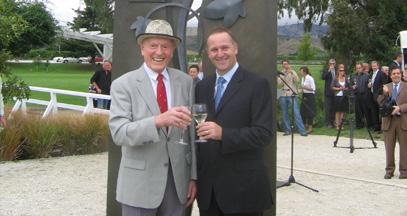
Frank wanted and how much he was prepared to pay for it. So Frank walked out and bought the farm next door, the whole 600 acre farm next to their industrial area.” Then there’s his call to place a massive banner across Queen Charlotte Sound/Tōtaranui, which would say “welcome to Montana”, ensuring all Cook Strait ferry passengers remembered the wine company’s name. It never eventuated, but was another example of thinking well outside the square.
Many years later, Frank was honoured by Pernod Ricard for his foresight at moving to Marlborough. “Without leaps of imagination or dreaming, we lose the excitement of possibilities,” he said at the time. “Dreaming after all is a form of planning. To accomplish great things, we must not only act, but also dream; not only plan but also believe.” He dreamed big and he achieved great things, but it wasn’t enough for him to stay on at Montana. By 1974, just a year after his vision to expand the company had played out, the board let him go. He later became a shareholder in Penfolds New Zealand and straight away encouraged the board to move into Marlborough. His vision was about to expand outside of the Montana vineyards. The rest, as they say, is history. Wayne says Frank was an incredible man, “a real worker and a real visionary… Probably the biggest the New Zealand wine industry has ever seen”. Where would Marlborough be now, if he hadn’t taken that punt back in 1973? Where would the New Zealand wine industry be if Marlborough had not later discovered how well Sauvignon Blanc grew in this region? It is very fitting that 10 days after Frank died, the Marlborough wine industry celebrated the results of the 2020 Marlborough Wine Show. The 49 Gold Medals delivered to the region’s wines are living proof that Frank’s prophesy that “wines from here will be world famous”, was spot on. Quotes in this story are from a book Tessa Nicholson is writing on the people and events that have shaped Marlborough’s wine industry. The book is due to be released to coincide with the 50th anniversary of the first vine planted by Frank Yukich in 1973.
WATER STORAGE SOLVED
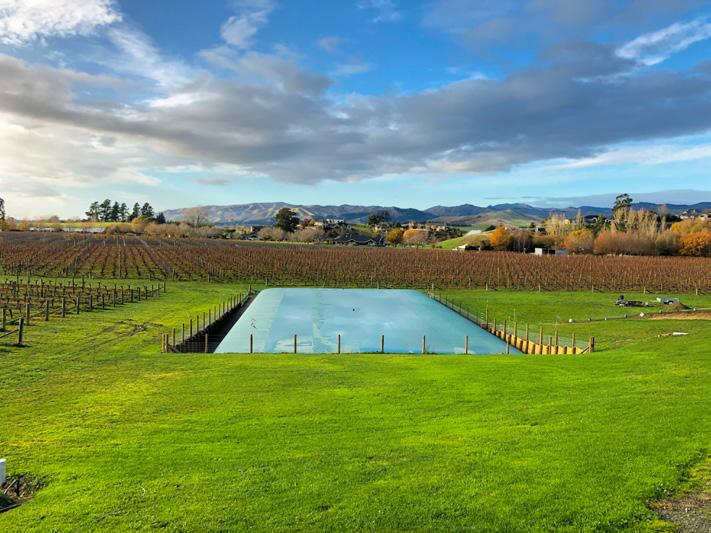
Flexi Tanks NZ are a cost effective solution ideal for horticulture, viticulture and agriculture. Our tanks are strong, enclosed bladders that can store anywhere from 1000 litres to 2,000,000 litres of liquid.
Rapid 1-2 hour installation with minimal site preparation Stores water as clean as the day it enters the tank 10 year manufacturer’s warranty & a 20 year life expectancy Storage options for grape marc leachate & liquid fertiliser
PHONE 07 829 5940 or 027 7063633 EMAIL andre@flexitanksnz.com WEB flexitanksnz.com
Biosecurity Watch
Chilean Needle Grass
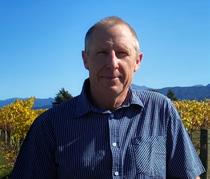
JIM HERDMAN
CHILEAN NEEDLE grass now occupies approximately 3,700 hectares in New Zealand, in Marlborough, North Canterbury and Hawke’s Bay. In the hot, dry summers in these regions, Chilean needle grass (CNG, Nassella neesiana) can rapidly establish in the absence of competition from other pasture species that tend to die off during this period. CNG has the potential to spread into over 15 million hectares of similarly dry land on the east coast of New Zealand and threaten agriculture and horticulture industries.
CNG infestation makes land unsuitable for sheep farming and aggressively out-competes and displaces pasture and desirable vegetation. In vineyards, CNG infests headlands, under vine areas, and inter-row spaces and surrounding hills, and is difficult to manage and control.
October, November, and December are the best months to look for CNG in the vineyard, surrounding headlands and pasture. At this time of year, it puts up distinctive seed spikelets of a reddish-purple colour, which fade to a light brown as the seeds mature. The seeds consist of a seed head about 10mm in length and a long twisted awn. The awn has short hairs down its length, enabling it to hook onto anything that passes. The sharp tip of the seed head can penetrate skin and clothing.
CNG has been a problem weed for farmers in Marlborough since the initial find and identification, back in 1946. It is also causes vineyard management issues in Marlborough, particularly in the lower Awatere Valley and around Blind River, where it is well established. Landowners and government have attempted over the years to restrict and halt the spread, and in recent years the Chilean Needle Grass Action Group (CNGAG) has been set up by landowners to champion control. I took the time to catch up with members of the group and vineyard staff who have been working hard to identify new ways to combat this weed successfully.
Annette Litherland works for the New Zealand Landcare Trust and supports the CNGAG, and has also been in charge of delivering the biosecurity earthquake recovery project. She has seen some successes in trials, including chemical topping, spot spraying, and direct drilling of competitive pasture species. She is also interested in how soil health and fertility can affect CNG and its ability to colonise areas. Annette is confident that new and effective management options can be found to reduce infestations in affected vineyards.
Warwick Lissaman has been part of the CNGAG for many years and has acted as its co-chairperson for much of that time. He sees one of the group’s main achievements as raising awareness around CNG control and management. As a result of increased awareness, he has seen a significant shift in landowner attitudes and the normalising of best practices around CNG vector control measures. Another achievement of the CNGAG is helping to acquire funding to research the best strategies to manage CNG. Warwick says the work done so far shows that landowners can definitely
Ryan Zhiguang Liu and Matt Gallop at Awatere Hills vineyard with an interrow planted out in rye grass to suppress CNG.
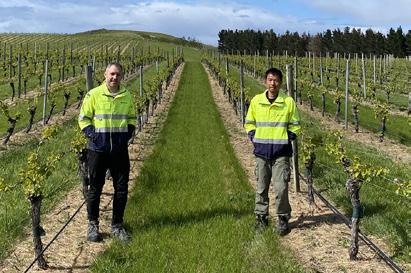
IF YOU SEE ANYTHING UNUSUAL CATCH IT. SNAP IT. REPORT IT.


Call MPI biosecurity hotline 0800 80 99 66
reduce CNG density using an integrated land management approach. The CNGAG were also involved in the development of the rules for the Regional Pest Management Plan (RPMP) to minimise the risk of spread.
Ryan Zhiguang Liu and Matt Gallop at Awatere Hills vineyard, a Constellation Brands New Zealand vineyard at Blind River, have been working on several trials with the CNGAG, including hard mowing (timing-critical), spot spraying, and chemical topping trials. The trial showing the most promise for vineyards is having every second interrow sward sprayed out with three rounds of herbicide (spring to summer) and left fallow, then direct drilling without cultivation in autumn with 30kg/ha Nui rye grass. All machinery traffic (spraying rounds) can operate on the other row for a year except for a few trimming and leaf plucking rounds. The result has been very encouraging - Ryan expects low (if any) reinfestation of CNG in the sown area, and there have been no machinery traffic issues. Over time the CNG may likely return, but the density will be significantly reduced.
The herbicide Taskforce has proven to be effective, but it cannot be used in vineyards due to the active ingredient flupropanate leaving residue in grapes. Taskforce can be used in areas where grapes are not present, but reseeding (drilling if possible) with a competitive pasture species is an essential part of treatment to reduce CNG reinfestation. Glyphosate is being spot-sprayed on CNG in vineyards, and while it temporarily reduces the number/density of CNG plants and makes properties comply with the RPMP, it does not prevent the germination of CNG seed in the cleared space. Ongoing research suggests there are potentially several competitive crops or pasture that could be introduced, which will reduce the re-establishment rate of CNG after treatment.
Identifying and restricting unnecessary access to areas known to be infested is extremely important to avoid spreading CNG. This may involve fencing off areas and the use of warning signage. Ensure anyone working in these
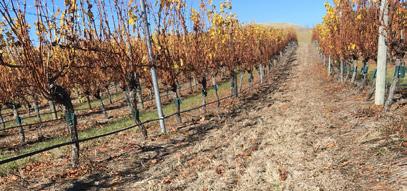
The interrow direct drilled with rye grass no cultivation.
areas follows biosecurity best practices and thoroughly cleans all equipment, machinery, and vehicles before leaving. People need to clean boots and carefully check clothing for any seeds. Ensure that your staff can identify CNG or have access to reference material so they will be able to identify it if it arrives on your site. Early detection and eradication is the best control measure so being able to identify the grass is crucial.
In Marlborough, the RPMP requires all landowners and occupiers with CNG to destroy it each year before seed set, unless a management plan is agreed with the Marlborough District Council.
For those properties where CNG is not present, it pays to have proactive biosecurity strategies in place to ensure it does not establish. Developing a biosecurity plan and undertaking hygiene protocols will help reduce the risk of CNG in your vineyard. Key prevention strategies to exclude CNG from your property include ensuring all vehicles and machinery coming on to your site are clean and free of plant material, seeds, and soil.
New Zealand Winegrowers (NZW) will keep members up to date with any new management recommendations as the CNG research projects progress. If you suspect you have a new infestation of Chilean needle grass in your vineyard or need information regarding CNG, you should contact the Marlborough District Council biosecurity team in the first instance. Biosecurity staff at NZW are also happy to help members with any inquiries - email us on: biosecurity@ nzwine.com
TIME TO UPGRADE YOUR ATV?
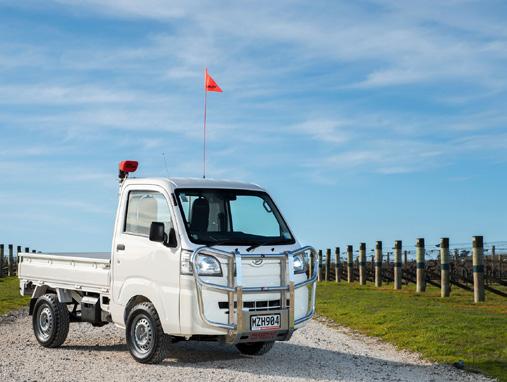
BASE MINITRUCK FROM $19990 + GST ON THE ROAD
ROAD LEGAL 4X4 WITH HI LOW RATIO PUSH BUTTON DIFF LOCK VEHICLE STABILITY CONTROL AIR CONDITIONING POWER STEERING FORWARD COLLISION RADAR LANE CHANGE ALERT DRIVERS AIR BAG LARGE DECK 2M X 1.4M THREE YEAR WARRANTY TOUCH SCREEN STEREO CONTACT SALES / ENQUIRIES 0226390689 / 0226390688 WWW.REDSTAGLMVD.CO.NZ
RED STAG COMMERCIAL VEHICLE SPECIALISTS AND NZ AGENT FOR INDESPENSION TRAILERS.
Industry News
Wine Marlborough Update VANCE KERSLAKE Appeals against the Marlborough Environment Plan decisions continue to slog through the Environment Court process. The Marlborough District Council has commissioned an external review on options for implementing the National Policy Statement and National Environmental Standard for Freshwater, and will then assess the impact on the appeals. In the meantime, the appeal parties agreed not to delay the process, because the timetable is drawn out enough to provide sufficient time for the review.
The second monthly vintage update was sent out at the end of October (wine-marlborough.co.nz/resources/). Wineries are working hard to recruit staff for vintage, but there is still a lot to be done to secure the workforce needed. A refresh of the Marlborough Labour Market Survey has been commissioned from Fruition – your cooperation would be very much appreciated if you are contacted by them.
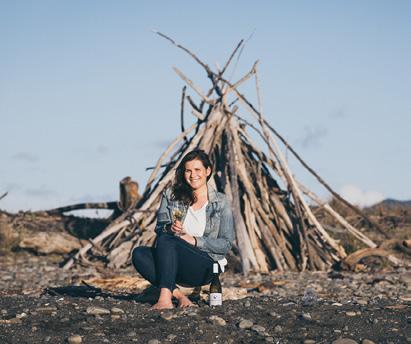
Kōparepare Whitehaven Wine Company relaunched its refreshed Kōparepare wine brand last month, with revenue from the first 125 cases sold online donated to LegaSea, a nonprofit organisation committed to the protection of New Zealand’s marine environment. Going forward, Whitehaven will donate $1 from every bottle of Kōparepare sold. Brand ambassador Samantha White is the daughter of Whitehaven founders Sue and Greg White and a staunch advocate for sustainability. “The protection and restoration of our oceans is not only a global concern but it is an issue that is deeply personal to me and something I feel passionate about. We are all responsible for change, and Kōparepare is a way for Whitehaven to invite wine consumers to be a part of the community that will action that change.” koparepare.co.nz BRI Open Day More than 100 wine industry members attended a recent open day at the Bragato Research Institute research winery, to look at the facilities and services offered. Winemakers, grape growers, and wine company staff were impressed with the extent of the capabilities of the facility, and the bespoke nature of much of the equipment, says business development manager Augusta van Wijk. For many it was their first time inside the winery since it opened in February, with access restricted during vintage and lockdown. The research winery trials equipment and technologies, winemaking processes, and sustainable winemaking and winery operations. It also provides commercial research winemaking services to suppliers and industry, and is available for trials for vintage 2021.
Research winery manager Dr Tanya Rutan explains the different tank options for wine trials.
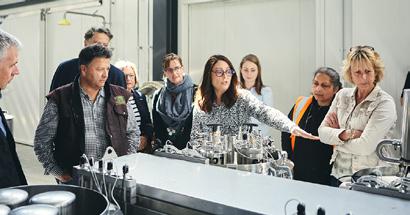
Botrytis Test Strips A company that made its name with a five-minute pregnancy test has utilised the technology to measure botrytis infection. The UK-based company Mologic was established after its co-founder Paul Davis created the Clearblue pregnancy test in the late 1980s, in the first commercial application of lateral flow technology. It’s currently working on a 10-minute Covid-19 test, with trials at Heathrow Airport. Meanwhile, Mologic has continued work with Champagne houses in Epernay, and more recently with the Australian wine industry, to deploy a fiveminute “pregnancy style”, test, as a simple and low cost way to identify and measure botrytis infection in must. Project leader Dr Alison Wakeham says that work has led to the recent launch of the Botrytis Alert test strips, and Mologic has started work with a New Zealand winery. For more information go to botrytisalert.co.uk
CLASSIFIEDS CONTRACT WINEMAKING 250T of space available at Framingham winery for 2021 vintage. Competitive Rates. Email: tom@framingham.co.nz Phone: 021 955 668
Montana Man Moves Three decades after he became a cellar hand at Montana’s Tamaki winery, Patrick Materman has moved to Indevin Group. Patrick came to Marlborough with Montana in 1994 and has worked with Brancott Estate ever since, becoming chief winemaker when it was bought by Allied Domecq in 2001 and continuing when Pernod Ricard Winemakers New Zealand bought the company in 2005, most recently with the job of global winemaker.
Patrick says he is pleased to have joined New Zealand-owned Indevin, which he describes as a “fascinating business” that “flies a bit under the radar”. Since it was founded in 2003, Indevin has become New Zealand’s largest wine producer, with more than 3,000 hectares of planted vineyards, and wineries in Marlborough, Hawke’s Bay, and Gisborne. Patrick says the company model has been disruptive, with a focus on partnering with wine retailers in Australia, the USA and the UK to develop wine brands at an industrial scale. It also works with large wine company partners in New Zealand, to deliver the wine they require.
It is a “pull” approach, driven by consumer demand, rather than the typical “push” of wine companies planting grapes, making wine and then seeking markets, he says.
Mechanical Shaking The 2020 vintage has reinforced the success of mechanical shaking for botrytis control, says viticultural advisor Mark Allen. “Despite the last two dry vintages, monitored blocks in 2020 again saw a 55% reduction in pre-harvest botrytis,” he says. The percentage reduction in botrytis is consistent every year, relative to the amount of disease pressure, he says. “In combination with a standard spray programme, mechanical shaking is a very effective cultural tool.”
Trials conducted last year indicated that early and late shaking were equally effective, although if the shaking is combined with crop reduction, it is better to wait until the bunches weigh more than 45 grams, he says. Points to remember this season include: • Shaking can be combined with crop thinning and trash removal as a single pass. The harvester settings are adjusted accordingly. • As a grower or vineyard manager, keep a close eye on the operation and check at least once an hour by placing a white tray under the harvester. • Ensure your harvester or contractor’s harvester has shields over the conveyor belts to allow the trash to land on a white tray or board under the harvester for monitoring the amount of trash being removed. • The harvester settings can be adjusted to remove the maximum amount of trash, which can be easily monitored on the white tray. Remember, the greater the amount of trash that can removed the better the botrytis control. • Ensure that you fine-tune and monitor the harvester settings to achieve the best result. “It’s a very different model to what most others in the industry are doing, and what I think is really strong about it is full partnership.”
Patrick’s role - head of winegrowing - includes acting as a conduit between overseas partners and the operations side of Indevin, translating market desires into planting and wine specifications. That includes input into the development of remaining land at Bankhouse Estate in Marlborough, “looking at what the needs are for the market and predicting what those needs are further out”. He notes that contracts with some major customers stretch out five or 10 years, “so there is a lot of surety around what that demand is”.
Patrick was chair of the inaugural International Sauvignon Blanc Celebration in 2016, and of the second successful event, Sauvignon 19 (see photo).

Mechanical shaking as a form of botrytis control was a serendipitous outcome of a trial to regulate crop loads, says Mark, who was involved in trials between 2011 and 2014, conducted by Plant & Food Research (PFR). “There is no other method that can guarantee a 55% reduction in botrytis if applied correctly.”
Trials are continuing this year with Thoughtful Viticulture and PFR to further investigate the response to mechanical shaking in relation to skin thickness and other metabolic changes which enhance the vines’ ability to reduce botrytis infection.
For more information, see the New Zealand Winegrowers fact sheet on mechanical shaking, or contact Mark on markallen@outlook.co.nz.
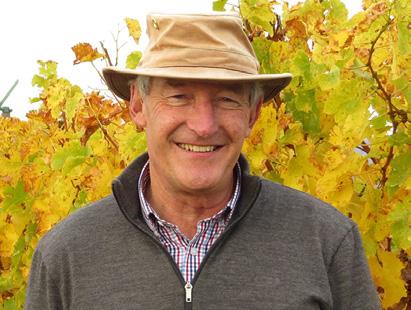
Wine Happenings
A monthly list of events within the New Zealand wine industry. To have your event included in December's Wine Happenings, please email details to sophie@sophiepreece.co.nz by November 20. Due to uncertainty around Covid-19, there may be changes to some of these events. For more information, please use the contact supplied or email sarah@winemarlborough.nz
NOVEMBER 2 Working for Nature/Mahi mō te Taiao applications open (bit.ly/MahiMoTeTaio) 2-6 New Zealand Winegrowers Biosecurity Week 2020 (nzwine.com/biosecurity-week) 5-8 Rapaura Springs Bloom in the Boom 2020 6 Tonnellerie de Mercurey Young Winemaker of the Year, national final. EIT, Hawke’s Bay 8 Blood Sweat and Beers interwinery cycling champs 10 2020 Rosé Workshop - New Zealand Society for Viticulture & Oenology (nzsvo.org.nz) 13 Marlborough Lab Network Seminar & Trade Fair, 9am-5pm, Marlborough Convention Centre 18 Working Smarter and Leaner seminar, 2pm-3.30pm Marlborough Research Centre Theatre. RSVP to advocacy@winemarlborough.co.nz 18 Wine Marlborough Annual General Meeting, 4pm Marlborough Research Centre Theatre 18 An evening with Peta Mathias, sponsored by Hunter’s Wine (hunters.co.nz) 27 Working for Nature/Mahi mō te Taiao applications close
FEBRUARY 12 Les Nuits Romantiques (''the Romantic nights") at Clos Henri
APRIL 24 Whitehaven GrapeRide (graperide.co.nz)
MAY 8 Saint Clair Vineyard Half (vineyardhalf.com)
Young Winemaker of the Year Nov 6

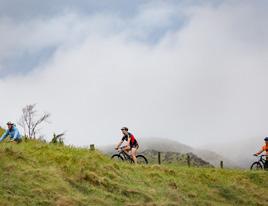
Blood, Sweat and Beers Nov 8

NZSVO Rose Workshop Nov 10
purchase fertiliser purchase fertiliser and keep your and keep your community thriving* community thriving*
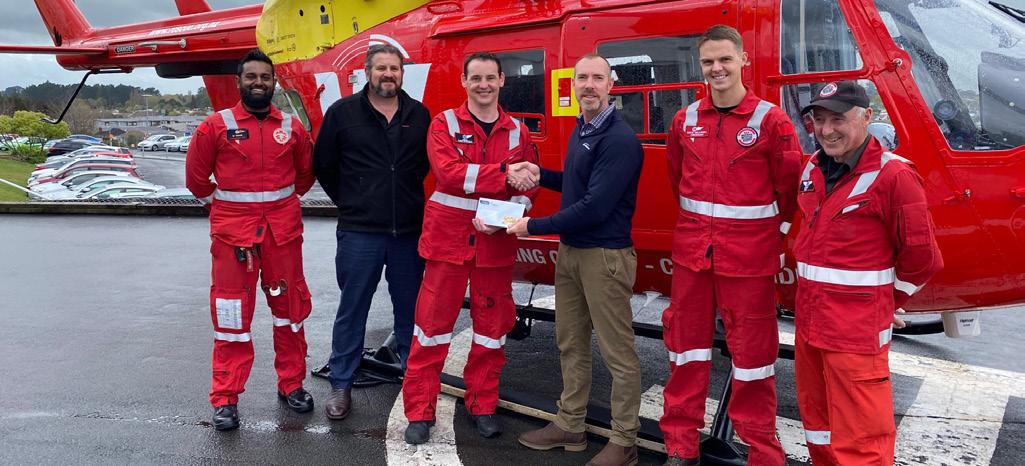
It’s the last month to nominate! Simply purchase Ballance Agri-Nutrients fertiliser through your PGG Wrightson account between 1 September 2020 and 30 November 2020 and $1 for every tonne purchased will be donated to your chosen qualifying cause* . It’s the last month to nominate! Simply purchase Ballance Agri-Nutrients fertiliser through your PGG Wrightson account between 1 September 2020 and 30 November 2020 and $1 for every tonne purchased will be donated to your chosen qualifying cause* .
Nominate your cause today at cashforcommunities.co.nz Nominate your cause today at cashforcommunities.co.nz
*Open to PGG Wrightson Ltd account holders only. Excludes Lime and Gypsum. See full terms and conditions at cashforcommunities.co.nz *Open to PGG Wrightson Ltd account holders only. Excludes Lime and Gypsum. See full terms and conditions at cashforcommunities.co.nz




